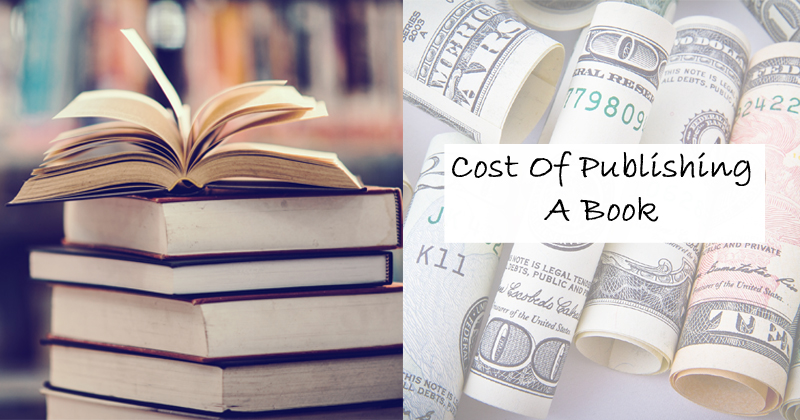
Whether you have finished writing a book or you are contemplating getting your work into the world at large, avenues these days are many. There are marketing agencies dedicated for your book; taking the marketing monkey off your shoulders. Indie publishing is costly in comparison to traditional publishing; but the gateway to getting your book out is broader. With indie publishing, you retain the rights to all your content, but there is a cost of publishing a book. Traditional publishing will produce the content for free, but there is a catch. Publisher have to pick you, which can be a long, arduous journey. Creative control is less and the publisher owns your content at the end.
So, What is the Cost of Publishing a Book?
The costs of publishing a book are incurred mainly in the following phases:
- Book Development Costs
- Book Production Costs
- Book Distribution Costs
- Book Marketing Costs
1. Book Development Costs:
Getting your book done professionally incurs a cost. There is, however, no cheap shortcut for preparing a book for publishing. The norm is only the best books sell. Most people who choose independent publishing are from a background that has no skillset to successfully get a book off the ground. Even practicing authors have to compete in a market where books are professionally produced. Quality is the basic prerequisite to sell widely. A stand-out cover design gets the reader to have a look into your book. The key in getting them to keep reading is a stellar plot and a structured form of storytelling. Well, spread-out characters create curiosity.
The costs of self-publishing a book vary greatly, ranging anywhere from $100-$6000 depending on book production costs such as formatting, design, editing, and more. The costs also vary depending on the genre a book is set in.

Few leading firms has performed research by genre for a combined average cost of developmental editing, copy editing, proofreading, cover design, and typesetting for an 80,000-word book. And the findings are as under:
Average Cost Of Publishing A Book by Genre:
Romance $3,819
Thriller, Mystery, and Crime $4,184
Science Fiction and Fantasy $4,300
Young Adult $4,132
Memoir $4,491
Literary Fiction $4,300
Business, Self-Help & Health $6,172
2. Book Production Costs:
There are two ways you can take to get printed copies of your book. Print on Demand and Volume Print(Offset). For about a decade now we have seen game-changing developments in printing technology. Print-on-demand has been around longer than that but now we’re seeing exquisite quality coming from these digital machines. Offering incredible advantages to self-publishers; advanced inkjet technology now creates pages and covers, that are nearly identical to those created with traditional offset printing.
In Print on Demand, the author chooses the format and creates a properly formatted book file. Onwards, digital printers print and assemble your book. PoD is cheaper upfront. It’s fast. And there is no wastage of pulping the book.
Offset printing is an older technology that uses plates that transfer an image onto a rubber blanket. It’s called “offset” because the ink is not transferred directly onto the paper, but the plates first. Afterward, that image is transferred onto a sheet of paper. For larger orders, this older printing method has its own advantages.
3. Book Distribution Costs:
The cost components in book distribution include Printing Cost, Profit Margin, and Wholesale discount (in case of Offset). It is only after specifying each of these elements, that the final retail price of the book is arrived at.

Example 1: Children’s Book (with heavy color printing)
Photo books have the richest color printing; so they are often used for Children’s Books; and not just for photography. A Standard Landscape Photo Book with a hardcover ImageWrap and 30 pages will cost $41.99 to print. Amazon’s fees for that book are $1.35 + 15% of the retail price. If your markup is $5.00, that photo book would be $55.38 on Amazon. In the case of a hardcover novel, the cost is less because of the volume and less image printing.
Suggested read: Few Unavoidable Costs Of Publishing A Book
4. Book Marketing Costs:
When it comes to marketing your book, you need to factor in the costs for as per under:
- Author Website: It can cost you around $ 1000 if got it done professionally. Development, maintenance, and hosting have to be accounted for.
- The Launch Program: Writing itself is not sufficient. One has to shout out about one’s book to the larger world. After all, reaching out to your target audience is your priority number one. There are service providers with whom you can connect with a media plan and do a paid launch with a book launching service. It may involve paid ads on social media, Amazon paid ads, paid search ads with Google. It might also incur the cost of paying for advertisement design. This can range from $50-$1,000 depending on how well you work with your social media and your local opportunities.
- Launch Events: A good understanding with an independent bookstore helps give you a space for a launch event. Also, if you do book promotion and launch events, speaking engagements, etc., without a publisher, there will be additional costs that will fall on you.

In summation, independent publishing means that you get to call the shots, work with your own timelines and set your own budget. There is so much freedom in self-publishing your own book. However, if you don’t have the resources to purchase top-of-the-line services right now, you can get started and grow your following and sales organically. You can learn along the way what works and what doesn’t; you will have to learn through some trial and error; and you may need to recycle earnings from your first round into your next attempts at indie publishing. It’s a journey, so enjoy all the learning as you go!





